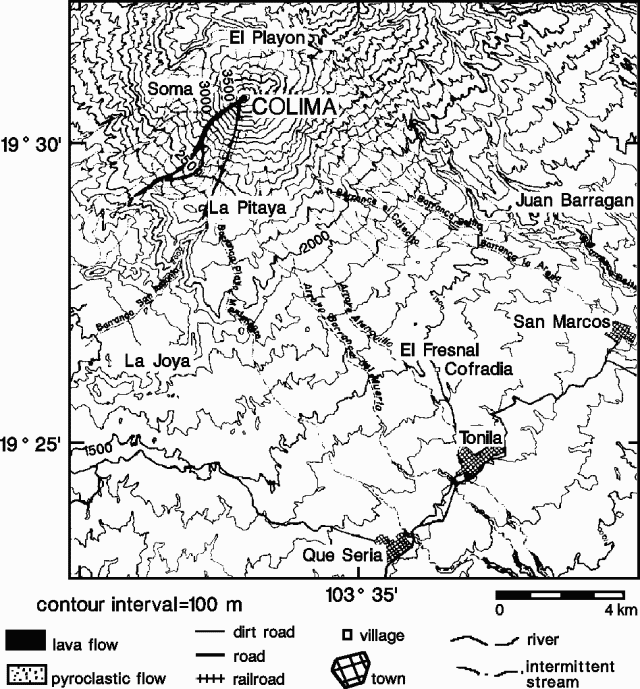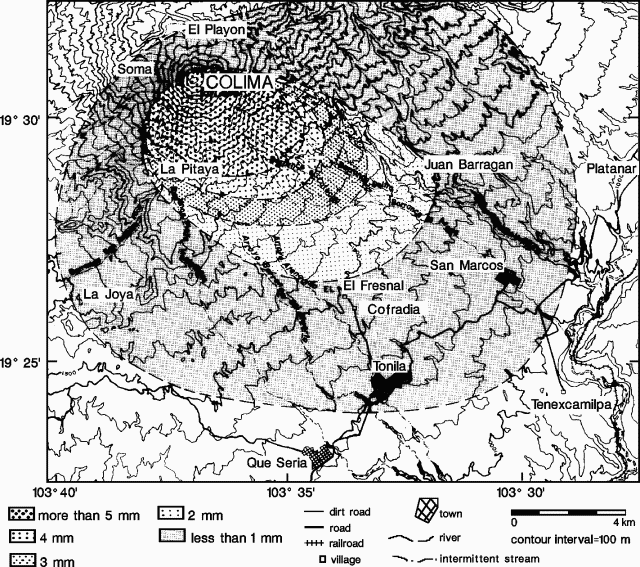Report on Colima (Mexico) — June 1991
Bulletin of the Global Volcanism Network, vol. 16, no. 6 (June 1991)
Managing Editor: Lindsay McClelland.
Colima (Mexico) Avalanching from summit dome; flank lava flow continues to advance; April tephra fall mapped
Please cite this report as:
Global Volcanism Program, 1991. Report on Colima (Mexico) (McClelland, L., ed.). Bulletin of the Global Volcanism Network, 16:6. Smithsonian Institution. https://doi.org/10.5479/si.GVP.BGVN199106-341040
Colima
Mexico
19.514°N, 103.62°W; summit elev. 3850 m
All times are local (unless otherwise noted)
CICT personnel visited the N and W flanks of the upper cone (El Playón and Soma areas) on 15 June, to observe morphological changes on the N and NW sides of the summit lava dome, and check reports of incandescence seen 8 June from nearby Nevado de Colima. Despite rainy weather, it was evident that a landslide 200-300 m long had occurred from the N side of the dome. A high-frequency seismic signal, interpreted as continuous avalanches, began at 1306 on 15 June and continued for about 30 minutes on RESCO stations EZV7 (at Volcancito, ~1 km NE of the summit) and EZV4 (on the NW flank). At 1440, RESCO seismometers recorded a large avalanche that lasted about 20 minutes, and was similar to the seismicity associated with the partial dome collapse on 16 April. The geologists saw a large fumarole and big reddish and yellow-brown dust clouds at 1450, while small gray plumes emerged from the dome; similar activity had been observed by a CICT team on 16 April. Morphologic changes were evident to the SSW side of the dome, probably from the partial collapse on 15 June, and the dome had decreased in height. The lava flow, about 20 m thick, continued to advance (down the El Cordobán canyon), reaching 3 km length and 2,500 m altitude (figure 14). Weather had prevented aerial monitoring of the lava flow.
 |
Figure 14. Topographic map of the Colima area, showing lava and pyroclastic-flow deposits on the SW flank. Courtesy of the Universidad de Colima. |
Mapping of 16-19 April airfall ash distribution showed that tephra volume was limited (figure 15). Unusual winds during the eruption carried ash to the SE. Small block-and-ash flows had been emplaced along the El Cordobán and Montegrande canyons; ashfall and block-and-ash flow deposits in the El Cordobán canyon area had been [significantly eroded] by the season's first rains.
 |
Figure 15. Isopach map showing ashfall from the 16-19 April activity at Colima. Courtesy of the Universidad de Colima. |
During the last two weeks in June, seismicity remained relatively constant, with no additional large avalanche episodes detected. There was no strong seismic evidence of impending changes in the eruption, but geologists recommended increased monitoring, including COSPEC analysis, to allow more complete evaluation of the activity.
Geological Summary. The Colima complex is the most prominent volcanic center of the western Mexican Volcanic Belt. It consists of two southward-younging volcanoes, Nevado de Colima (the high point of the complex) on the north and the historically active Volcán de Colima at the south. A group of late-Pleistocene cinder cones is located on the floor of the Colima graben west and east of the complex. Volcán de Colima (also known as Volcán Fuego) is a youthful stratovolcano constructed within a 5-km-wide scarp, breached to the south, that has been the source of large debris avalanches. Major slope failures have occurred repeatedly from both the Nevado and Colima cones, producing thick debris-avalanche deposits on three sides of the complex. Frequent recorded eruptions date back to the 16th century. Occasional major explosive eruptions have destroyed the summit (most recently in 1913) and left a deep, steep-sided crater that was slowly refilled and then overtopped by lava dome growth.
Information Contacts: Francisco Núñez-Cornú, Julián Flores, F. Alejandro Nava, R. Saucedo, C. Valencia, Ariel Ramírez-Vázquez, G.A. Reyes-Dávila, R. García, and J. Hernández, CICT, Univ de; Z. Jiménez, S. de la Cruz-Reyna, and I. Yokoyama, UNAM; P. Lesage (France); D. Córdoba, UCM, Spain.

